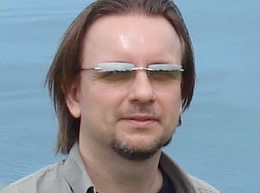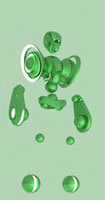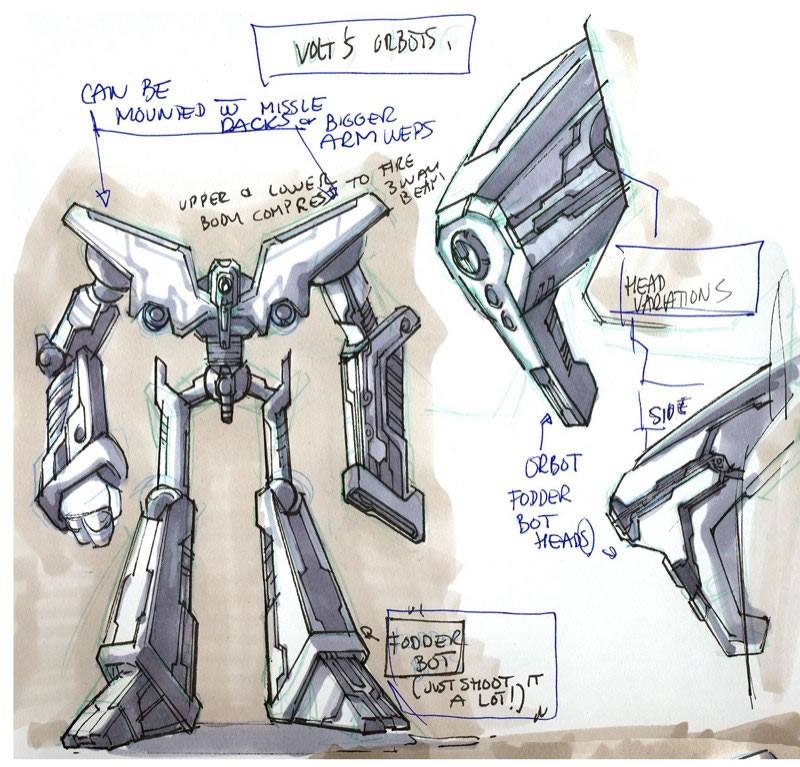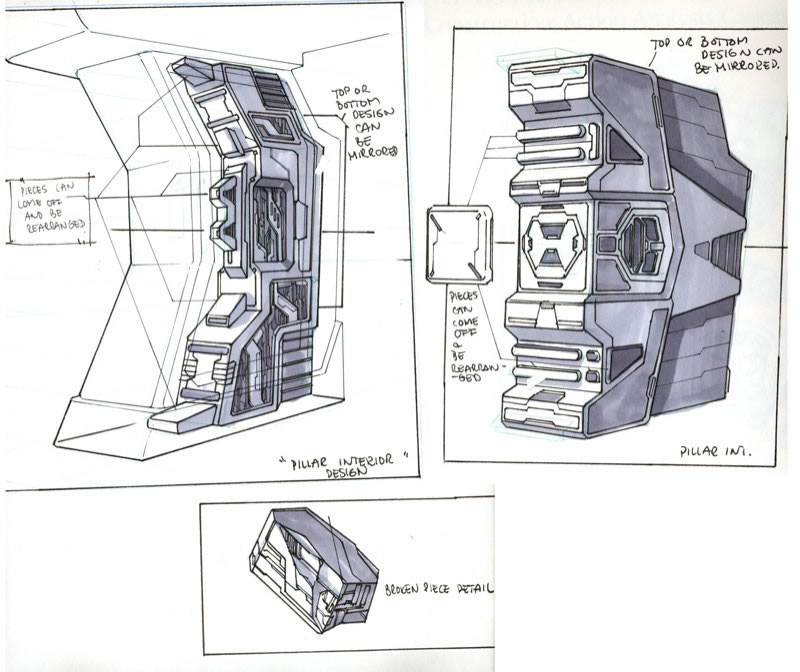In November of 2003, Sega made the grim announcement that it was halting development of the new VectorMan title for the Playstation 2. Hopes of seeing this great character revived were dashed, and the franchise has remained dormant ever since. At the time, no official  reason was given for the game’s cancellation, and most people attributed it to the standard “not the right time for this project” policy that compels many publishers to shelve games in development. Fans sighed in resignation and moved on.
reason was given for the game’s cancellation, and most people attributed it to the standard “not the right time for this project” policy that compels many publishers to shelve games in development. Fans sighed in resignation and moved on.
This past April, concept art of the unfinished VectorMan game surfaced on former lead production designer Frank Trzcinski’s website. Sensing a chance to get to the full story behind this stillborn sequel, Sega-16 contacted Mr. Trzcinski for an interview. An artist, modeler and art director with more than a decade of experience, he has worked on such hits as the Full Auto series, Sam and Max, and Disney’s upcoming Gnomeo & Juliet feature. Trzcinski was quite forthcoming about the game, and he shed some much-needed light on this unfinished sequel.
Sega-16: How did you get involved with the project?
Frank Trzcinski: In the spring of 2003 I was interviewed by Pseudo for a concept artist position. The project in studio at that time was a re-imagining of Vectorman for the Playstation 2, a title undergoing visual and generational departure from it’s 16 bit brethren. My previous experience in creating concept and development art in animation and games along with my environmental technical design approach helped me land a job there. I felt very fortunate to land with a small creative team that had a great property at hand. Having a love of all things Sega, Robotics, Industrial environmental design and gaming certainly helped as well.
Sega-16: Was Sega intent on bringing VectorMan back intact, or did it want the character changed and upgraded for modern audiences?
Frank Trzcinski: Sega wanted a title direction and character change that had a more serious overtone for gamers. There was a lack of that clear character and game direction when I stepped in. Internally, the VM model was not satisfying anyone’s idea of what he should look and behave like, but that model was a lock for E3 at that time. The E3 levels catered to a gun shooting platforming soldier-type character so any changes to his design would have to had been done later.
Previous visual and game design testing of the character I saw was extensive, working iterations like the original character’s Orbot ball set with energy links (looked pretty cool), to the often compared Halo Master Chief/Gundam inspired efforts (internally called “Vector-Chief”) There were clearly several months worth of ideas conceptualized, modeled and implemented prior to my arrival on the scene.
To summarize, Yes, Sega wanted a upgraded looking character, it had been extensively explored, the design wasn’t set and was a work in progress right up to E3.
Sega-16: How much of the previous two games would have appeared in this sequel, in terms of enemies, environments, etc.?
Frank Trzcinski: Certainly the concept of the Orbots, the mechanical world and robotic enemies, platforming elements, gunplay and general destruction were all going to be included. The rest was still to be determined and a work in progress.
Sega-16: VectorMan apparently evolved from his floating sphere form into a more solid body, supposedly due to a past defeat and rescue by a secret someone. Product manager Chris Chord said it was to give the game a more mature and serious look. Do you agree with this? Vectorman’s floating sphere body was something of his calling card to many gamers.
 Frank Trzcinski: My personal preference would have been to respect and stay true to the original character designs, heritage, and fan base while evolving them to look like VM’s aesthetic, abilities, and humor had seamlessly and naturally transitioned from a 2D to 3D world. Transformations of the character would have been a great design to carry over to the new title.
Frank Trzcinski: My personal preference would have been to respect and stay true to the original character designs, heritage, and fan base while evolving them to look like VM’s aesthetic, abilities, and humor had seamlessly and naturally transitioned from a 2D to 3D world. Transformations of the character would have been a great design to carry over to the new title.
Pseudo did have previous concept designs for the traditional VM ball look, here (left) is an image of one of the VM models that was proposed.
Sega-16: Was Sega restrictive in any way about using VectorMan and his world? Did it make any specific demands?
Frank Trzcinski: I was given creative conceptual reign over the visual look. Environment-wise it was open for interpretation; the project was still in design iteration. We were, in a way, starting fresh with the art I was about to create. The concept created was in response to then-current game design documentation. Themes such as character transformation held true for the series so I set about creating an Orbot landscape that was very much mechanical and integrated with its environments and citizens. For example, enemies, props and vehicles would be incorporated as parts of building like a natural camouflage, blending in and receiving power from the structures around them. Upon VM’s approach they would “awaken” and “transform” into floating vehicles, platforms, enemy types. Essentially, the environment and its inhabitants acted as one large cohesive mechanical organism.
Sega-16: The video footage of the game that survives shows it to be true to the run-‘n-gun roots of the series, only translated to 3D. That’s promising, considering how many franchises stumble making the transition from 2D to 3D. How much of a VectorMan “feel” do you think gamers would have gotten from playing this new installment?
Frank Trzcinski: The design paid homage to the original game’s roots, the platforming, shooting, frantic pacing, robotic enemies, boss fights and destruction mechanics would have all been familiar to fans. This was evident across all of the builds I had played.
Sega-16: The game was reported to have around 80% of its environments be destructible. How did you plan out them out in 2D? How did the process work?
Frank Trzcinski: We planned out environmental and prop based designs with the team from 2D designs through to 3D models that detailed how the structures looked internally and externally. We were still negotiating the overall visual foundation for the game, so the conceptual destruction design was at that time secondary but forming. The core idea was to have structures reveal support skeletons once you blew out the outer layers. The procedural damage we had in the demos was going to be used as the base for our destruction design. How far we were going to be able to take this destruction idea was still a work in progress. Here is an example of one of the pillar support drawings that details this philosophy.
Sega-16: Why was the game canceled?
Frank Trzcinski: I would be speculating as to why it was canceled but it did happen shortly following E3.
Sega-16: Do you think there’s a chance we could ever see VectorMan again? Would you like to be involved with it if it were brought back?
Frank Trzcinski: I would surely entertain being involved in a future VM project. The concept art, freedom of design and the overall aesthetic of the series hits close to home for me, it would be a great challenge and a lot of fun to give it another go.
Our thanks to Mr. Trzcinski for taking the time for this interview. To see more great concept art, as well as a video of the transitions from 2D to 3D, head over to his website.



Recent Comments